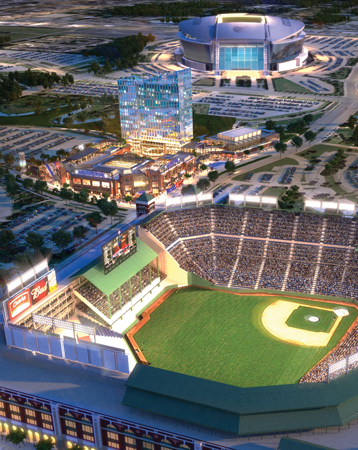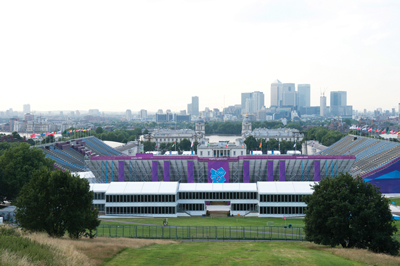Thomas Scarangello, Thornton Tomasetti: “Dynamic — both literally and figuratively. As the cost of facilities rises, their ability to adapt — to environmental, programmatic and technological change — will be key to meeting long-term goals. A 25- to 50-year obsolescence is not sustainable.”
Bob Fatovic, CannonDesign: “We’re going to see shifts away from stadiums surrounded by a sea of parking and a move toward ‘Stadiums in the Park’ and venues that are richly connected with their community.”
Dan Meis, Meis Architects: “Smaller, mobile, maybe even completely temporary. I believe the stadium of the future might be no stadium at all but rather a ‘pop-up’ venue that occupies important urban centers in the same way Siena’s Piazza del Campo becomes a stadium for a legendary horse race twice a year.”
Tom Paci, Turner Construction: “More concentration on the fan experience (family/kids’ areas, upgraded food
 |
Projects such as Texas Live! expand sports venues into year-round entertainment districts.
Photo by: The Cordish Cos. |
service, interactive experiences, enhanced audio visual, etc.), and more concentration on income-producing program elements (smaller suites, more club and loge seats, super suites for game-day rental, more advertising opportunities, etc.).”
Ken Johnson, Hunt Construction Group: “More focus on the 1 percent crowd and providing more super-premium product to make sure there is differentiation and exclusivity for this fan base. Much more interactive fan experience at the sports stadium or arena to draw fans out of the house or other recreational items into the sports facility to watch a live game. More areas where there is opportunity for fans to mingle, watch the game and socialize; less hard, fixed seating.”
Mitchell Ziets, Tipping Point Sports: “Smaller venues, with increased social (standing room only) spaces offering lower ticket prices to attract millennials, reduced number of suites (NFL venues excepted), creative food and beverage concepts and spaces, and more adaptable music/social spaces (plazas, club spaces) open year-round. Plus, alternative uses of practice facilities (e-sports, clubs).”
Chase Martin, The Cordish Cos.: “The sports venues of the future will be integrated into their surroundings. There will be a blurring of lines between game-day and non-game-day facilities and operations. There will no longer be traditional concession stands but rather immersive restaurants and dining options that encourage fans to come early and stay late. Unique media content will be featured in stadium to supplement the live game experience, and technology will be a driving force of stadium infrastructure.”
Gerardo Prado, HNTB: “Slightly smaller venues, with fewer, better seats close to the action, enabling the energy of the fans to impact the outcome of the game, is the future.”
Len Moser, Barton Malow: “Flexibility of the venue and new technologies will increase to improve the fan experience. Sports facilities will be adaptable throughout their lifespan, without returning to the experience of watching games in the ‘concrete donuts.’”
Don Barnum, DLR Group: “The venue of the future won’t just host eight or 24 or 82 events a year. It will be flexible and able to accommodate hundreds of events for any number of audiences. It will be green and sustainable, have its own renewable energy system and be off the grid. To ensure that all these events occur, an operable roof will be a standard device. The fan experience will be extremely customized down to the level of each individual who enters the venue.”
Randy Shelly, Shawmut Design and Construction: “Technology is, and will be, huge, as are the experiences being created in-stadium. It won’t be your father’s stadium anymore: catering to millennials means more lounge-like experiences, with more opportunity to explore and socialize.”
Jon Niemuth, AECOM: “There will continue to be a strong focus on community identity and engagement in all aspects, from fan experience to sustainability. Venue design will be less about replicating the same venue plan over and over and more about creating unique spaces that connect to fans, cities and communities.”
Paula Portz, PC Sports: “We’ve spent at least the last 10 years focused on technology and providing patrons with the ability to connect multiple devices, stream content, and have unlimited bandwidth. So much today in film and media is virtual reality, so I would hope that the sports venue of the future changes the focus back to the playing field or court, and not so much on the smartphone.”
Matt Rossetti, Rossetti: “Loss of the concept of ‘upper deck’ for ROI and experiential purposes. Upper seating bowls are the inverse of ROI for sports in that they produce the least revenue, cost the most and deliver very little in the way of patron experience.”
Brad Schrock, HOK: “The sports facility of the future will be an ultra-connected, sustainable, adaptable and multiuse environment. In addition, the buildings will get smaller and more intimate to provide a truly unique experience.”
Dale Koger, Legends Project Development: “With media rights providing so much of the revenue for each league/conference/franchise/collegiate team, in-venue technology demands will drive design, and even the bowl configuration itself, to optimize TV coverage, and thereby continue driving media rights and sponsorships higher.”
Marc Farha, Icon Venue Group: “I think we will continue to see the venues associated with a master development in the adjacent spaces that keep the venue central to a live/work/play theme. We will also see the connectivity with technology as a reaction to multiple demographics and what they expect from technology and offerings to keep up with their daily lives (multitasking with work, ease of access to concessions and restrooms, etc.). That reaction to demographics is also going to force us to continue to evolve the premium seating offerings.”
 |
Pop-up, temporary venues like those used at the London Olympics could become common.
Photo by: Getty Images |
Tom Tingle, Skanska:
■ “Higher levels of flexibility allowing annual facility upgrades to meet demand trends.
■ Plug-and-play amenities: suite and club seat pods that can be changed per game.
■ Sustainable operations and energy usage; net zero is the norm, not the exception.
■ Sophisticated technology backbone that is easily and affordably upgraded to meet increased and changing demands.”
Kacie Renc, JMI Sports: “Sports venues of the future will be more deeply integrated within their urban environments. The ticketed area will be pushed further out to incorporate plazas and streets, creating an entertainment district that offers a much richer game-day experience than one confined within the facility’s exterior façade and adjacent parking lot.”
Earl Santee, Populous: “My prediction is the sports venue of the future will not be just one venue or one place. It will be an entire development of multiple venues in one place. It’s no longer just about one building; it’s about building a community.”
Bill Rhoda, Legends Global Planning/CSL International: “The average spending on technology in new facilities will grow from what is today 3 to 5 percent to upwards of 20 percent of the overall facility development costs. The continued growth of technology spending will expand beyond Wi-Fi and mobile phone connectivity as technology will impact everything from parking, energy efficiency, wayfinding to data collection, security, and food and beverage operations.”
Erleen Hatfield, BuroHappold Engineering: “A lot more high tech, Wi-Fi and video integration in the fan experience and more sustainable too. Also, the future holds well-designed, more iconic buildings to attract fans.”
Bill Johnson, HOK: “We need to look beyond the building as the confines of the experience. To what degree will sports and entertainment venues transform from actual structures into stage sets for media production and virtual experiences, and what will be the economic, environmental and social drivers that facilitate this change?”





